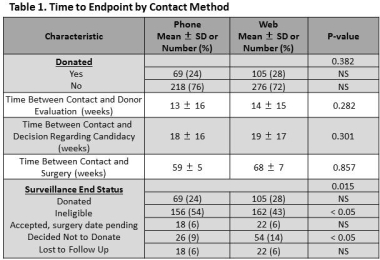Are Living Kidney Donors Who Apply Via a Web-Based Screening Application as Likely to Be Evaluated and Donate as Compared to Phone Applicants?
Vanderbilt University, Nashville.
Meeting: 2015 American Transplant Congress
Abstract number: B192
Session Information
Session Name: Poster Session B: Living Donor Issues 1
Session Type: Poster Session
Date: Sunday, May 3, 2015
Session Time: 5:30pm-6:30pm
 Presentation Time: 5:30pm-6:30pm
Presentation Time: 5:30pm-6:30pm
Location: Exhibit Hall E
Purpose: Most transplant centers screen self-referring donors using phone and written surveys. Previous research at our center has shown that a web-based application for screening of living kidney donors increases donor inquires and efficiency of the initial screening process. The aim of this study was to examine the impact of the web-based application on the entire evaluation and donation process.
Methods: Single center, retrospective study of medically evaluated living donors who interfaced with the transplant center between January 2011-March 2014 via the telephone or web-based application. Data were analyzed using t-tests, nonparametric tests of proportions, Kaplan-Meier survival, and multivariable Cox proportional hazards regression methods.
Results: 287 evaluated donors (43%) contacted the center via the phone as compared to 381 (57%) via the web. Evaluated patients who contacted the center via the web were more likely to have a graduate degree (p<0.05) and to live more than 400 miles from the transplant center (p=0.023). There was no significant association between contact method (phone or web) and the time to evaluation (p=0.282), decision regarding candidacy (p=0.301), or donation surgery (p=0.857). There was no significant difference in the number of donor surgeries (p=0.382) between groups, but those who contacted via the phone were more likely to be turned down for medical reasons (p<0.05), while those via the web were more likely to decide not to donate (p<0.05). 
Conclusions: Potential living kidney donors who contact via the phone or web are equally as likely to be medically evaluated at the transplant center and subsequently donate. The two contact modes lead to an equally efficient management process as there is no difference in the time to evaluation, decision regarding candidacy, or donation. Future efforts should be aimed at those patients who decide not to donate and reasons why to determine if modifiable factors are present that could be addressed in hopes of increasing the number of eligible living donors.
To cite this abstract in AMA style:
Schaefer H, Tanaka M, Feurer I, Dreher A, Newbern P, Moore D. Are Living Kidney Donors Who Apply Via a Web-Based Screening Application as Likely to Be Evaluated and Donate as Compared to Phone Applicants? [abstract]. Am J Transplant. 2015; 15 (suppl 3). https://atcmeetingabstracts.com/abstract/are-living-kidney-donors-who-apply-via-a-web-based-screening-application-as-likely-to-be-evaluated-and-donate-as-compared-to-phone-applicants/. Accessed December 22, 2025.« Back to 2015 American Transplant Congress
